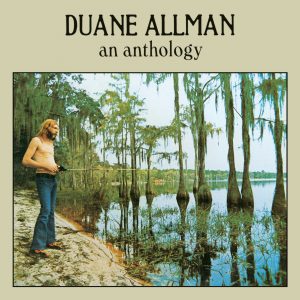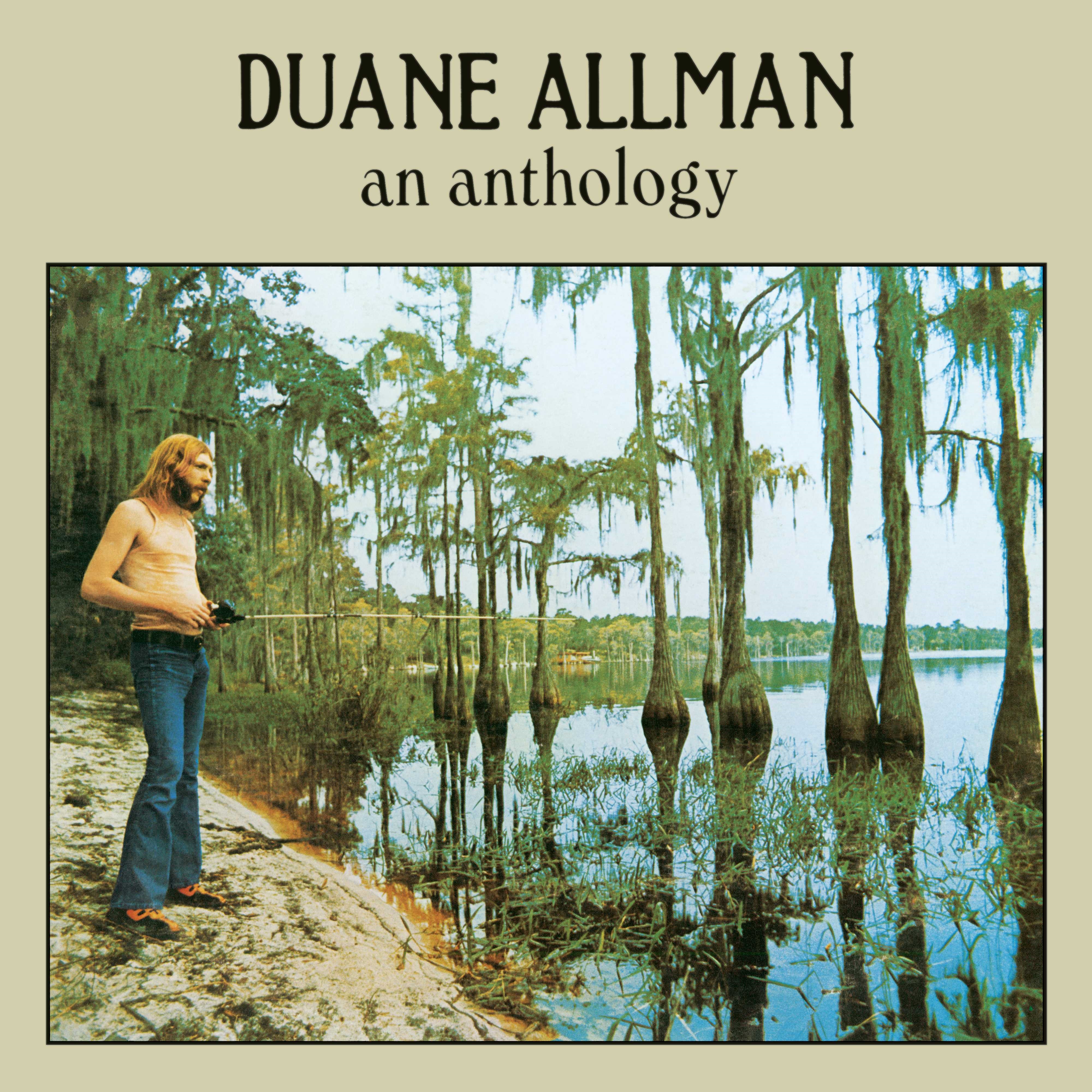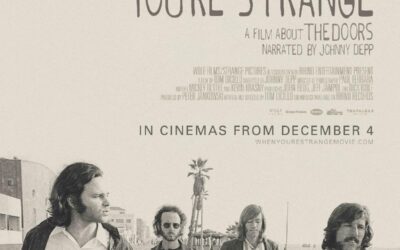Double LP includes 19 cuts from guitar icon’s brief, but powerful career with session work for fellow legends and historic moments with The Allman Brothers Band, Eric Clapton
By Harvey Kubernik c 2016
Few artists have had as large an impact on popular music in such a short period of time as legendary guitarist Duane  Allman. In just four years, Allman laid down session tracks for some of music’s most important stars, founded one of rock ‘n’ roll’s most influential collectives and redefined the lead guitar, spawning multiple generations of guitar heroes who continue to rediscover his genius 45 years after his tragic death at age 24.
Allman. In just four years, Allman laid down session tracks for some of music’s most important stars, founded one of rock ‘n’ roll’s most influential collectives and redefined the lead guitar, spawning multiple generations of guitar heroes who continue to rediscover his genius 45 years after his tragic death at age 24.
On October 28, Mercury/UMe reissued Allman’s long-out-of-print 1972 double LP, An Anthology, on standard 120-gram vinyl. The career-defining retrospective was released in two installments shortly after Allman’s death in a 1971 motorcycle accident in Macon, Ga. The release coincided with the October 29 anniversary of his death and comes about a month before he would have turned 70, on November 20.
The record is available as a limited edition run on heavyweight 180-gram vinyl complete with a reproduction of the 20-page booklet that accompanied the LP’s original release. A special bundle pairs the album together with a vintage feel t-shirt of the LP cover. These audiophile must-haves are available directly via: http://flyt.it/DuaneAllman
Duane Allman’s impact on rock is incalculable, influencing players and exciting fans through non-stop exposure on radio, in popular culture and through the sounds of the legion of players who’ve mimicked him over the years. An Anthology captures Allman in the many guises he somehow developed in just four years – from his time as a session musician at the iconic FAME Studios in Muscle Shoals to his fraternization with fellow legend Eric Clapton and his fiery, virtuoso work with the Allman Brothers Band.
The double LP opens with a 20-year old Allman showcasing his blues player skills with a devilish slide hand and epic sense of grandeur on the track “B.B. King Medley” recorded with his bandmates Hour Glass in 1968. Allman caught the attention of Rick Hall, visionary producer at Muscle Shoals, and decided to put him on Wilson Pickett’s version of the Beatles’ “Hey Jude” which led to another huge opportunity for Allman when Atlantic Records’ Jerry Wexler heard his work and bought out his contract. That led to sessions with Aretha Franklin, Boz Scaggs, John Hammond, King Curtis, Bonnie & Delaney & Friends and Clarence Carter, all of whom are represented on An Anthology.
Around the same time Allman founded the Allman Brothers Band and moved the group to Macon, where they began to redefine rock ‘n’ roll with a blend of fire and ice – high energy solo runs provided by Duane and laid-back cool provided by his brother Gregg – that still reverberates in pop music today as country music artists and fans rediscover and reinterpret 1970s Southern rock. The closing side of the second platter includes benchmark Allman Brothers recordings such as the sound-defining “Statesboro Blues,” the lowdown boogie “Stand Back” and the spacy, jazz-influenced “Dreams” and “Little Martha.”
The collection also includes his work with Clapton on the Layla and Other Assorted Love Songs sessions, one of music history’s most memorable super-power team-ups. The recordings here, laid down in Miami where Clapton met and befriended the guitarist in 1970, include Derek & The Dominos’ “Layla” and the Clapton recording “Mean Old World,” a jovial acoustic back and forth between the two guitar masters.
Acclaimed multi-instrumentalist Chris Darrow looks back at Duane Allman’s seminal time in Southern California during 1967-1968.
In December of 1967 I was in New York playing my last gigs with the Kaleidoscope before leaving the band. Jeff Hanna and John McEwen of the Nitty Gritty Dirt Band approached me about joining their group. McEwen had worked at Disneyland while I was playing bluegrass with the Mad Mt. Ramblers in 1963. We used to perform in front of the Mine Train Ride across from the Silver Slipper Saloon. He and Steve Martin worked at Coke Corner doing magic tricks and were both bluegrass-style banjo players. They would come to get pointers from our banjo player, David Lindley, when we were on our breaks.
In turned out that that John’s brother, Bill McEwen, managed the Dirt Band and also handled a group called the Sunshine Company, Steve Martin and a band from the south called the Hour Glass. The Hour Glass featured the singing of Greg Allman and the guitar playing of his brother, Duane.
I got to know the guys, especially Duane, who spent a lot of time with Ralph Barr, the guitarist in the Dirt Band. Los Angeles was the band’s base and since I lived in Claremont, 35 miles to the east, I hung out a lot with Ralph, his wife Holly and Duane during that time.
The Hour Glass recordings were overproduced and didn’t do very well. However, when playing a live show, they sounded like a blues band that could have come from Muscle Shoals, Alabama.
California in the sixties was the center of the new musical movement formed by the psychedelic revolution, but they just didn’t quite fit into the situation. However, Duane reputedly started playing slide guitar when he saw Taj Mahal perform at the Golden Bear in Huntington Beach.
One night on December 10th of 1967 the Dirt Band had a radio interview at a club called the Magic Mushroom in Studio City hosted by Phil Procter and Peter Bergman of the Firesign Theater for their Radio Free Oz program on KRLA. I had a blue, 1954 Ford two-door and had some room in the car for some riders. Jeff Hanna was in my front seat and Duane wanted to come along for the ride.
We all had heard earlier in the day that Otis Redding had been killed in a plane crash somewhere in Wisconsin. I will never forget Duane sobbing in the back seat of my car over the death of his main man. I remember back to the time when I cried uncontrollably when I found out about the death of Buddy Holly and Ritchie Valens. When our heroes go what else is there to do?
The second Hour Glass album, Power of Love, came out in 1968. Greg was a great singer, Duane played wonderful guitar but times got tough in L.A. so he decided to go to Muscle Shoals, Alabama and became a session player at Rick Hall’s studio.
Duane and I kept in touch over time and after I had left the Dirt Band I began to tour with Linda Ronstadt, John Stewart and Hoyt Axton. While in Linda’s band I usually roomed with Bernie Leadon. While spending a few months in the New York area, we were living at the Chelsea Hotel on 22nd street.
One day I got an exited call on the phone. It was Duane Allman and he had just gotten his first National resonator guitar and he had to show it to us. He had gotten it at Manny’s Music, as I recall, and he was bursting with enthusiasm. Both Bernie and I were Dobro players and we all ended up sitting around with him taking turns and talking about tunings and technique. Duane was a natural slide player and learned to play real fast. He used a glass Coricidin bottle as a slide for his playing.
He was on his way to Florida, where he would meet Eric Clapton and record with him the music that would eventually become the Layla sessions.
(Harvey Kubernik has been a music journalist for over 44 years and is the author of 8 books. During 2014, Harvey’s Kubernik’s Turn Up the Radio! Rock, Pop, and Roll in Los Angeles 1956–1972 was published by Santa Monica Press. In 2017, Sterling will publish Kubernik’s 1967 Complete Rock Music History on the Summer of Love).






